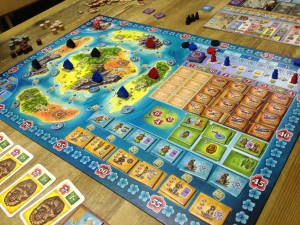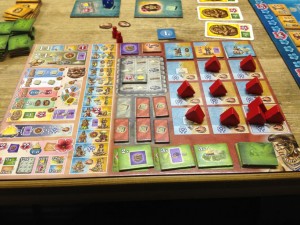Review: Bora Bora
Posted by James (admin) on March 15th, 2013
 Stefan Feld’s games are known for having an interesting mechanic at their heart, which is one of the reasons I look forwards to his games. Bora Bora is no different and has a dice-placement-action system in the centre of a game that isn’t complicated but it does have a lot of other game mechanics and bits surrounding it. No specific aspect is complicated, but there is a lot going on, so I’m going to try to discuss each main part one-by-one.
Stefan Feld’s games are known for having an interesting mechanic at their heart, which is one of the reasons I look forwards to his games. Bora Bora is no different and has a dice-placement-action system in the centre of a game that isn’t complicated but it does have a lot of other game mechanics and bits surrounding it. No specific aspect is complicated, but there is a lot going on, so I’m going to try to discuss each main part one-by-one.
OVERVIEW
The game is set on a Pacific island and players place huts, gain tribe members, build buildings, make offerings to the gods, and so on. The game lasts 6 rounds and the winner is the player who finishes with the most victory points (VPs). Many VPs are earned during the game, but there are also lots of bonus VPs that can be awarded at the end of the game (although, as you’ll read later, these are quite tough to achieve).
Each round players first roll their 3 dice and then take turns placing one at a time on one of the action tiles allowing them to perform the appropriate action. Next, players use the ability of one of their man tiles and the ability of one of their woman tiles. Then, the status track (scoring VPs and determining turn order), temple track (scoring VPs and a bonus for one player) and jewelry purchases are all resolved. Finally, players must complete or discard one of their 3 objective tiles before taking a new one. (All unclaimed man and woman tiles, objectives and jewelry are cleared from the board and new ones added for the next round.)
THE BOARDS
In the middle of the table is the game board showing the 12 island areas (split across 5 islands) as well as the temple track, status track, etc. Plus, each player has their own board which, at first glance, look quite bewildering; however, the left-hand third of the board is actually a useful player information card. The main area of the player board has 12 spaces which are initially filled with huts (apart from one). Empty spaces are important because man and woman tiles can only be placed on empty spaces, so you constantly need to manage making space (primarily by using the ‘Expand’ action to place huts onto the main board).
The player’s board also has space for the player’s current 3 objective tiles (see below) and the player’s building zone – a 3×4 grid and each square shows one of the 3 building materials. When a player gains building materials, they are placed on a matching square. When a player builds a building, they place one of their 2×1 building tiles onto the grid replacing (and spending) 2 materials which are covered up.
 PHASE 1: THE CORE DICE ACTION PLACEMENT SYSTEM
PHASE 1: THE CORE DICE ACTION PLACEMENT SYSTEM
Next to the main board are the very important action tiles. These show the different actions a player may be able to take on their turn.
- Gain a man/woman: Take one man/woman tile from the display and place on your player board in an empty slot
- Expand across land/water: Place a hut from your player board onto a main board area that is adjacent to an area containing one of your huts
- Build: Place a building tile onto your player board (which replaces the materials already laid out there)
- Temple: Send one of your 3 priests to the temple track
- Helper: This does lots of small things (explained below)
- Fishing: Earns a flat 2VPs
(Some actions are combined onto a single tile with fewer players which is a nice balancing mechanic ensuring there is always competition over placing dice on the action tiles.)
At the start of each round, all players roll their 3 dice. They then take turns placing one dice each and performing the associated action. A dice can place be placed on any action tile BUT the dice must be a lower value than any dice already on that action tile. ALSO, the value of the dice placed determines how much effect the action has – the higher the number placed, the better the options or greater the effect.
For example, the ‘gain a man’ action tile allows a player to take one of the 6 man tiles on display; however, placing a dice value of 2 only allows the player to take one of the 2 left-most tiles, whereas, placing a 5 would allow them to take any one of the 5 left-most tiles. Another example is when expanding to place a new hut – each path between adjacent areas has a numbered value; therefore, placing a 4 on the ‘expand’ action allows the player to expand from one of their current huts in any direction marked with a value of 4 or lower.
This is clever in two ways. First, there’s no such thing as a bad dice roll – you may not roll what you want but all combinations have their advantages. The reason for this is that high-value dice are great to give you more effect to your actions but they’re harder to place than low values once other players have placed dice on actions. Conversely, low-value results may not give you large effects but they’re usually easier to place.
Second, as all players can see each others’ dice, there is scope for humorous screwage by placing a dice knowing it will block another player. Turn order makes a big difference so it can be important to earn a better position. I mainly rolled 1’s and 2’s all game but I was first player a lot so placing my first 1-value dice blocked an action before anyone else could use it – mwa-ha-ha-haaa…
So, this game mechanic delivers some clever effects as well as a lot of tension as you wait to see if someone else will block you from an action you plan to use (like many worker placement games). I liked how another player’s use of an action before you doesn’t always block you out from using it – it depends on the number, and how much they want to be mean to you. I think the different dice outcomes can alter the feel of a game as sometimes the actions will be easier to gain but not so during other games. Also, the results other players roll will affect how you consider using your dice too.
It’s important to note that some types of God cards can be played to override the dice placement rules – one type allows you to place a dice normally but activate it like it was a 6, and another type lets you ignore any previously placed dice. So, these are very useful but they do come at the cost of using actions to gain both the cards and the offerings that must accompany them.
I’ll mention here that a player can always place a dice on the ‘Fishing’ action to gain 2VPs no matter what other dice are there. I thought this would get used a lot, but we only used it twice in our game (even with my low rolls) so there’s usually some worthwhile action to do.
Helper Action
The ‘Helper’ action does several smaller items and allows the player to spend their die value on several different things such as upgrading males or females (once each only), moving huts on the player board, and gaining building materials, god cards and offerings tokens. Upgrading males gives them tattoos (giving status which in turn earns VPs and sets player order); whereas, upgrading females lets them collect shells which can be spent to make jewelry (which earn VPs).
Status and Turn Order
Turn order makes a big difference so gaining status during a turn is good so you are earlier in turn order. However, gaining a little status each round doesn’t earn as many VPs as gaining the same total status but in a single round. Yet another interesting game mechanic to balance.
Temple Track
The temple track has 6 slots for the players’ priests. New priests are added by using the ‘Temple’ action allowing the player to places their priest on any slot equal to their dice’s value or lower. A priest already on the same slot is bumped down one and this can have a chain reaction that bumps a priest off the end, which means higher-value priests are likely to last longer. Players earn VPs for each priest plus a bonus for the player with the most priests in the temple.
PHASE 2: USING THE MEN AND WOMEN TILES
After all players have used their dice for actions, each player gets to use one of their man tiles and one of their woman tiles. The effects are things such as build a building, place a hut, take god cards, earn prestige, etc. There are multiple man and woman tiles of the same type and a player with multiple identical man (or woman) tiles gets a better effect. For example, having one man tile that lets you build a building value 1-3, but having two of these man tiles would let you build a building value 1-6. Whilst the powers of the men and women may seem slight, they are important and can give you an edge over your opponents. It’s interesting to balancing having multiple different types (so you have a choice of effects) against having multiple similar types to boost their effects. Also, having no women or no men is a bit of a waste as you’re not maximising your gains.
 PHASE 3: END OF ROUND ACTIVITIES
PHASE 3: END OF ROUND ACTIVITIES
At the end of each round, players resolve the status track (which determines the new turn order and earns VPs), resolve the temple track (VPs for each priest plus bonus for player with most priests), and make jewelry (spending shells to make the jewelry tiles on display for that round). Finally, the player must complete or discard an objective before taking a new one.
The Objective System
The objective system is interesting as each player always has 3 objective tiles (which are public information) on their player board. Objectives cover all sorts of things such as having 3 different male tiles, having huts on 4 different terrain types, showing 3 identical god cards, etc. At the end of each round, players MUST complete one objective tile on their board or discard one. A player can reduce one requirement on an objective with a specific god card but this scores 4VPs, instead of scoring 6VPs for an objective completed without help. After this, players each take one of the new objectives from those on display on the main board (in player order) to replace the one they removed.
The objectives mechanic is another clever system as all players are viewing the board slightly differently (an aspect I always like), plus players are forced to develop in directions they may not have considered, players can see what each other are aiming for, and a player can keep an objective (so they can plan on completing it in a later turn) so long as they complete/discard a different one.
END OF THE GAME SCORING
After 6 rounds, players will still have 3 objective tiles (as they take a new one in the final round like other rounds). Players now complete or discard these 3 objectives as usual, so a player can complete up to 9 objectives throughout the game.
Now, final scoring takes place. There are VPs for unused God tiles (joker God cards requiring no offerings), VPs for the fish value of each area (earned by the most recent player to expand into each area) and VPs for jewelry tiles (1-9VPs each).
Lastly, there are 9 separate ways players can score 6 extra VPs. Players score 6VP if they have completed 9 objectives, built all 6 buildings, placed all 12 huts, and so on. They are each quite demanding and require focus so I’d be amazed if a player can complete them all and score 54 bonus VPs.
It was the one area of the game that I found a bit odd – the different methods are hard to achieve so require a lot of focus – any slip up and you’ll fail, so the reward seemed quite small for the effort required. In future, I’m not sure I would go out of my way quite as much to achieve the more ‘fragile’ of the bonuses such as completing 9 objectives as any discarded objective along the way can not be re-gained; whereas filling the construction grid is a bit more forgiving as you can buy multiple materials or build multiple buildings in any single round. Also, a couple seemed too closely linked such as 6VPs for placing all huts and 6 VPs for having 12 tribes people – that seems odd as you can’t place all 12 tribe members unless you have placed all 12 huts.
CONCLUSION
As you can see from the above there is a lot going on in Bora Bora, but it’s not a complicated game, just rich in content. As a result, it’s not a good game for players who have not played many board games, but is great for more experienced players and also probably a good introduction to deeper games for those already familiar with simpler eurogames.
The central dice-placement-action game mechanic is very clever, works well and I love how rolling low can be just as good as rolling high. There is real anticipation when players roll their dice and they want to see what they and other players rolled. Ideally you want a mix of high and low.
However, Bora Bora is more than just this clever mechanic as it is in the middle of a very rich game, rather than being naked and feeling very obvious. There are lots of elements to balance and you always want to achieve more than you’re able to each turn.
Overall, I thought Bora Bora was an excellent game and I look forwards to playing it more.
James.
[Played with 3 players]

